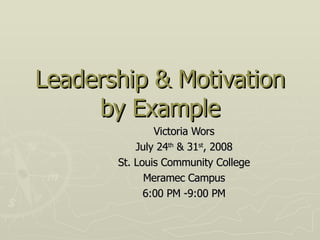Leadership By Example Notes
•Download as PPT, PDF•
8 likes•2,720 views
How to create trust, integrity by leading by example.
Report
Share
Report
Share

More Related Content
What's hot
What's hot (20)
Viewers also liked
Viewers also liked (20)
The Lean Startup (Theory & Motivation - Examples & Learnings)

The Lean Startup (Theory & Motivation - Examples & Learnings)
Suggestions for adaptations_to_a_communication_board

Suggestions for adaptations_to_a_communication_board
Similar to Leadership By Example Notes
Similar to Leadership By Example Notes (20)
Wyoming Hospital Association, part 2, Strategies for Building a Culture of Ow...

Wyoming Hospital Association, part 2, Strategies for Building a Culture of Ow...
Navigating Troubled Waters: Leading the Process of Change

Navigating Troubled Waters: Leading the Process of Change
BFBM(10-2016) Leading Your Team Greatness (UTinZanKyaw) 

BFBM(10-2016) Leading Your Team Greatness (UTinZanKyaw)
Soft Skills as Transferable Skills - What, Why & How? 

Soft Skills as Transferable Skills - What, Why & How?
Are your people afraid - Learn Level III conversation

Are your people afraid - Learn Level III conversation
More from Victoria Wors
More from Victoria Wors (8)
Recently uploaded
Unveiling Falcon Invoice Discounting: Leading the Way as India's Premier Bill...

Unveiling Falcon Invoice Discounting: Leading the Way as India's Premier Bill...Falcon Invoice Discounting
Recently uploaded (20)
Falcon Invoice Discounting: Empowering Your Business Growth

Falcon Invoice Discounting: Empowering Your Business Growth
Unveiling Falcon Invoice Discounting: Leading the Way as India's Premier Bill...

Unveiling Falcon Invoice Discounting: Leading the Way as India's Premier Bill...
Lundin Gold - Q1 2024 Conference Call Presentation (Revised)

Lundin Gold - Q1 2024 Conference Call Presentation (Revised)
Al Mizhar Dubai Escorts +971561403006 Escorts Service In Al Mizhar

Al Mizhar Dubai Escorts +971561403006 Escorts Service In Al Mizhar
Getting Real with AI - Columbus DAW - May 2024 - Nick Woo from AlignAI

Getting Real with AI - Columbus DAW - May 2024 - Nick Woo from AlignAI
Jual Obat Aborsi ( Asli No.1 ) 085657271886 Obat Penggugur Kandungan Cytotec

Jual Obat Aborsi ( Asli No.1 ) 085657271886 Obat Penggugur Kandungan Cytotec
Challenges and Opportunities: A Qualitative Study on Tax Compliance in Pakistan

Challenges and Opportunities: A Qualitative Study on Tax Compliance in Pakistan
QSM Chap 10 Service Culture in Tourism and Hospitality Industry.pptx

QSM Chap 10 Service Culture in Tourism and Hospitality Industry.pptx
How to Get Started in Social Media for Art League City

How to Get Started in Social Media for Art League City
Berhampur CALL GIRL❤7091819311❤CALL GIRLS IN ESCORT SERVICE WE ARE PROVIDING

Berhampur CALL GIRL❤7091819311❤CALL GIRLS IN ESCORT SERVICE WE ARE PROVIDING
Ooty Call Gril 80022//12248 Only For Sex And High Profile Best Gril Sex Avail...

Ooty Call Gril 80022//12248 Only For Sex And High Profile Best Gril Sex Avail...
New 2024 Cannabis Edibles Investor Pitch Deck Template

New 2024 Cannabis Edibles Investor Pitch Deck Template
Berhampur Call Girl Just Call 8084732287 Top Class Call Girl Service Available

Berhampur Call Girl Just Call 8084732287 Top Class Call Girl Service Available
Horngren’s Cost Accounting A Managerial Emphasis, Canadian 9th edition soluti...

Horngren’s Cost Accounting A Managerial Emphasis, Canadian 9th edition soluti...
UAE Bur Dubai Call Girls ☏ 0564401582 Call Girl in Bur Dubai

UAE Bur Dubai Call Girls ☏ 0564401582 Call Girl in Bur Dubai
Berhampur 70918*19311 CALL GIRLS IN ESCORT SERVICE WE ARE PROVIDING

Berhampur 70918*19311 CALL GIRLS IN ESCORT SERVICE WE ARE PROVIDING
Marel Q1 2024 Investor Presentation from May 8, 2024

Marel Q1 2024 Investor Presentation from May 8, 2024
Chennai Call Gril 80022//12248 Only For Sex And High Profile Best Gril Sex Av...

Chennai Call Gril 80022//12248 Only For Sex And High Profile Best Gril Sex Av...
Nashik Call Girl Just Call 7091819311 Top Class Call Girl Service Available

Nashik Call Girl Just Call 7091819311 Top Class Call Girl Service Available
Leadership By Example Notes
- 1. Leadership & Motivation by Example Victoria Wors July 24 th & 31 st , 2008 St. Louis Community College Meramec Campus 6:00 PM -9:00 PM
- 3. What do we mean when we say “Leadership & Motivation by Example”?
- 42. What We Have Learned
Editor's Notes
- Ask if anyone was not in the right class Introduction of self and getting others to introduce themselves. Announce where rest room locations, breaks and take attendance
